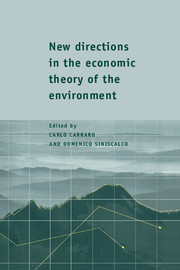Book contents
- Frontmatter
- Contents
- List of contributors
- 1 Theoretical frontiers of environmental economics
- 2 Growth with natural and environmental resources
- 3 Environmental policy and technological innovation
- 4 Environmental policy, distortionary labour taxation and employment: pollution taxes and the double dividend
- 5 International coordination of environmental taxes
- 6 Environmental policy and international trade
- 7 Environmental regulation and international capital allocation
- 8 Towards a theory of international environmental cooperation
- 9 Group formation in games without spillovers
- 10 Non-cooperative models of coalition formation in games with spillovers
- Index
5 - International coordination of environmental taxes
Published online by Cambridge University Press: 11 January 2010
- Frontmatter
- Contents
- List of contributors
- 1 Theoretical frontiers of environmental economics
- 2 Growth with natural and environmental resources
- 3 Environmental policy and technological innovation
- 4 Environmental policy, distortionary labour taxation and employment: pollution taxes and the double dividend
- 5 International coordination of environmental taxes
- 6 Environmental policy and international trade
- 7 Environmental regulation and international capital allocation
- 8 Towards a theory of international environmental cooperation
- 9 Group formation in games without spillovers
- 10 Non-cooperative models of coalition formation in games with spillovers
- Index
Summary
Introduction
Politicians and others often argue that environmental policy, and in particular environmental taxes, ought to be coordinated across countries. Two types of arguments for the desirability of international coordination of environmental taxes are frequently given. The first argument states that uncoordinated tax policy will lead to unequal taxes across countries, with a corresponding distortion of the relative competitiveness of countries. Related to this argument is also the fear that when environmental taxes are set individually at the country level, each country's concern about its own competitiveness may imply that environmental taxes throughout are set too low. The starting point of the second type of argument is that several important environmental problems are characterised by international spillovers, i.e., that the environment in one country depends not only on emissions in this country, but also on emissions in one or more other countries. When the environmental problem is international in this sense, environmental policy must also be coordinated according to this type of argument.
This chapter makes a closer study of the arguments for an international coordination of environmental taxes. Section 2 covers the first type of argument, in the context of an environmental problem with no international spillovers. It is first shown that under ‘ideal conditions’ there is no need for international coordination of environmental taxes. ‘Ideal conditions’ include the following assumptions: (a) there are no market failures other than the environmental externality, (b) governments maximise the welfare of a representative household, (c) the environmental externality can be monitored at the micro level, e.g., emission levels from a firm or consumption levels of a good which has a negative impact on the environment.
- Type
- Chapter
- Information
- New Directions in the Economic Theory of the Environment , pp. 105 - 146Publisher: Cambridge University PressPrint publication year: 1997
- 4
- Cited by



